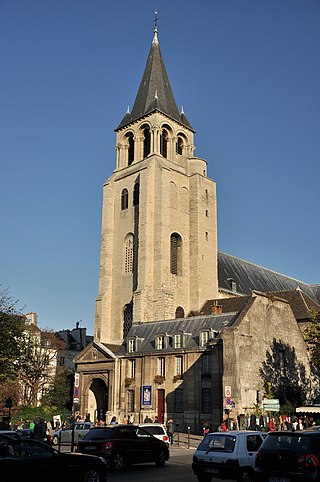
The Palais de Justice, is a judicial center and courthouse in Paris, located on the Île de la Cité. It contains the Court of Appeal of Paris, the busiest appellate court in France, and France's highest court for ordinary cases, the Court of Cassation. It formerly housed the Tribunal de grande instance de Paris which was relocated in 2018 to a new high-rise building in Paris's Batignolles neighborhood. The Palais de Justice occupies a large part of the medieval Palais de la Cité, the former royal palace of the kings of France, which also includes Sainte Chapelle, the royal chapel, and the Conciergerie, a notorious former prison, which operated from 1380 to 1914. It is located in close proximity to the Tribunal of Commerce, the Prefecture of Police of Paris, and the offices of the Paris Bar Association.

Île de la Cité, 22.5 hectares in size, is one of two natural islands in the Seine, in central Paris. In the 4th century, it was the site of the fortress of the area governor for the Roman Empire. In 508, Clovis I, the first King of the Franks, established his palace on the island. In the 12th century, it became an important religious center, the home of Notre-Dame cathedral, and the royal chapel of Sainte-Chapelle, as well as the city hospital, the Hôtel-Dieu. It is also the site of the city's oldest surviving bridge, the Pont Neuf.

The Palais Bourbon is the meeting place of the National Assembly, the lower legislative chamber of the French Parliament. It is in the 7th arrondissement of Paris, on the Rive Gauche of the Seine across from the Place de la Concorde.

The Palace of Justice of Brussels or Law Courts of Brussels is a courthouse in Brussels, Belgium. It is the country's most important court building, seat of the judicial arrondissement of Brussels, as well as of several courts and tribunals, including the Court of Cassation, the Court of Assizes, the Court of Appeal of Brussels, the Tribunal of First Instance of Brussels, and the Bar Association of Brussels.

The Brussels Stock Exchange, abbreviated to BSE, was founded in Brussels, Belgium, by decree of Napoleon in 1801. In 2002, the BSE merged with the Amsterdam, Lisbon and Paris stock exchanges into Euronext, renaming the BSE Euronext Brussels. The most well known stock market index on the BSE is the BEL20.

The Palais Rohan in Strasbourg is the former residence of the prince-bishops and cardinals of the House of Rohan, an ancient French noble family originally from Brittany. It is a major architectural, historical, and cultural landmark in the city. It was built next to Strasbourg Cathedral in the 1730s, from designs by Robert de Cotte, and is considered a masterpiece of French Baroque architecture. Since its completion in 1742, the palace has hosted a number of French monarchs such as Louis XV, Marie Antoinette, Napoleon and Joséphine, and Charles X.

The Palais de la Cité, located on the Île de la Cité in the Seine River in the centre of Paris, is a major historic building that was the residence of the Kings of France from the sixth century until the 14th century, and has been the center of the French justice system ever since, thus often referred to as the Palais de Justice. From the 14th century until the French Revolution, it was the headquarters of the Parlement of Paris. During the Revolution it served as a courthouse and prison, where Marie Antoinette and other prisoners were held and tried by the Revolutionary Tribunal. Since the early 19th century, it has been the seat of the Tribunal de grande instance de Paris, the Court of Appeal of Paris, and the Court of Cassation. The first of these moved to another Parisian location in 2018, while the other two jurisdictions remain located in the Palais de la Cité as of 2022.

The National Academic Library is a public library in Strasbourg, France. It is located on Place de la République, the former Kaiserplatz, and faces the Palais du Rhin.

The city of Paris has notable examples of architecture from the Middle Ages to the 21st century. It was the birthplace of the Gothic style, and has important monuments of the French Renaissance, Classical revival, the Flamboyant style of the reign of Napoleon III, the Belle Époque, and the Art Nouveau style. The great Exposition Universelle (1889) and 1900 added Paris landmarks, including the Eiffel Tower and Grand Palais. In the 20th century, the Art Deco style of architecture first appeared in Paris, and Paris architects also influenced the postmodern architecture of the second half of the century.

The Palais Universitaire in Strasbourg is a large, neo-Renaissance style building, constructed between 1879 and 1884 under the direction of the German architect Otto Warth. It was inaugurated in 1884 by Wilhelm I, Emperor of Germany. Through Avenue de la Liberté, it faces the equally monumental former imperial palace (Kaiserpalast).

Skjold Neckelmann was a Danish-German architect, best known for designing four Strasbourg buildings that are landmarks of the Neustadt district - the National and University Library, the National Theatre, the Palais de Justice and Saint-Pierre-le-Jeune Catholic Church.

The National Theatre of Strasbourg is a palace building on Strasbourg's Place de la République, now occupied by a theatre company of the same name, the National Theatre of Strasbourg.

The architecture of Paris created during the Belle Époque, between 1871 and the beginning of the First World War in 1914, was notable for its variety of different styles, from neo-Byzantine and neo-Gothic to classicism, Art Nouveau and Art Deco. It was also known for its lavish decoration and its imaginative use of both new and traditional materials, including iron, plate glass, colored tile and reinforced concrete. Notable buildings and structures of the period include the Eiffel Tower, the Grand Palais, the Théâtre des Champs-Élysées, the Gare de Lyon, the Bon Marché department store, and the entries of the stations of the Paris Metro designed by Hector Guimard.

The Hôtel de Hanau, also known as the Hôtel de ville and as the Hanauer Hof, is a historic building located on the Place Broglie on the Grande Île in the city center of Strasbourg, in the French department of the Bas-Rhin. It was designated a monument historique by the French government in 1921.

The Neustadt is a district of Strasbourg, Bas-Rhin, France. In 2017, the heart of the district was listed as a World Heritage Site by UNESCO, as an extension of the site including the older city centre and Strasbourg Cathedral. The district is a unique example of city planning, merging the Haussmannian model with elements of German architecture and urban planning.

The Palais des Fêtes is a music venue in the Neustadt district of Strasbourg, in the French department of the Bas-Rhin. Built for the male choral society of Strasbourg in 1903, it has served as the principal concert hall of the city and home to the Orchestre philharmonique de Strasbourg until 1975. It has been classified as a Monument historique since 2007.

The Strasbourg Opera House, located on Place Broglie on the Grande Île in the city center of Strasbourg, in the French department of the Bas-Rhin, is the main seat and mother house of the opera company Opéra national du Rhin. It has been classified as a Monument historique since 1921.

The Episcopal Palace, formerly known as the Hôtel du grand Doyenné, is the seat of the Archdiocese of Strasbourg. A French Baroque hôtel particulier of the 1720s, it is located between Rue du Parchemin and Rue Brûlée, near Place Broglie, on Grande Île, the historic city center of Strasbourg, in the French department of the Bas-Rhin, Alsace. It has been classified as a monument historique since 1929.

The Place de la République is one of the main squares of the city of Strasbourg, France. It is surrounded on three sides by five buildings only, of which none is residential: the Palais du Rhin, the National and University Library, the Théâtre national de Strasbourg, the Préfecture of Grand Est and Bas-Rhin, and the tax center Hôtel des impôts. All of these buildings are classified as monuments historiques. The fourth side of the square is devoid of buildings.

Saint-Pierre-le-Jeune Catholic Church is a late 19th-century Catholic church dedicated to Saint Peter in Strasbourg, France. It is not to be confused with the medieval Saint-Pierre-le-Jeune Protestant Church in the same city.
























